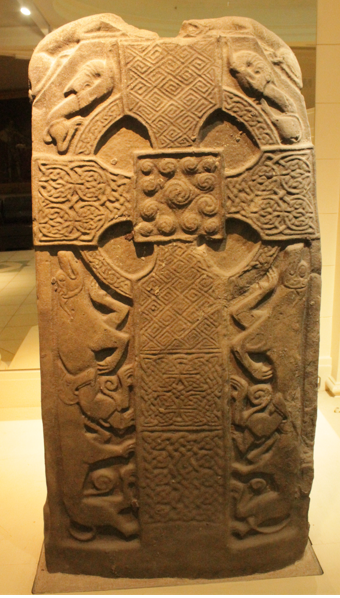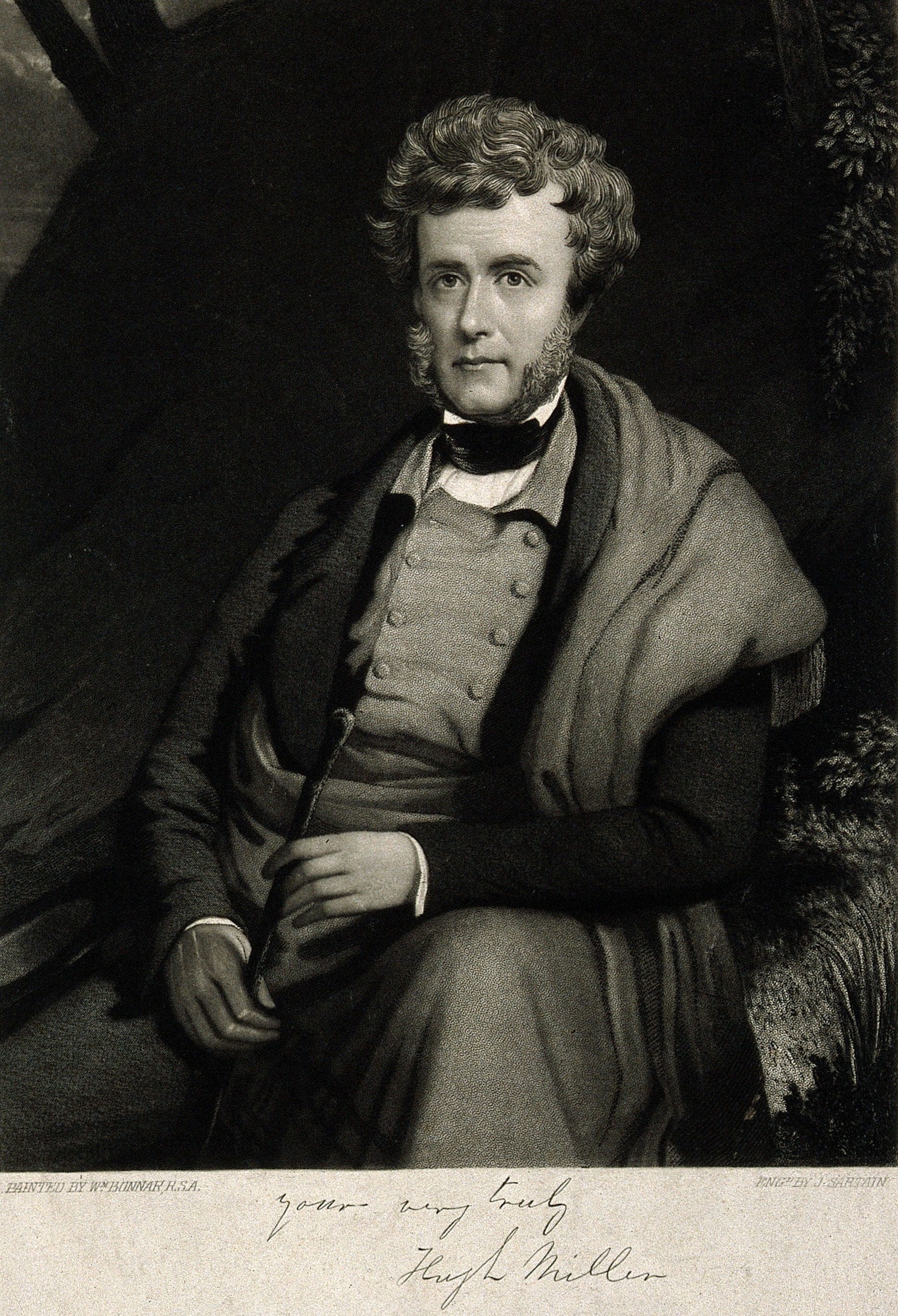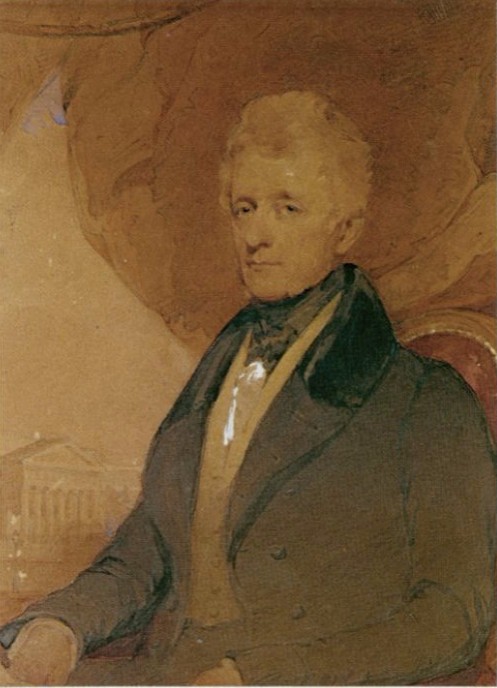|
James Noble (geologist)
James Noble (1800–1848) was a 19th century Scottish minister, antiquarian, geologist and fossil collector. In relation to his fossil hunting, Hugh Miller called him " a gentleman who, by devoting his leisure hours to geology, has extended the knowledge of this upper formation, and whose name has been attached by Agassiz to its characteristic fossil, now designated as Holoptychus Nobilissimus". Life He was born in New Deer in Aberdeenshire the son of Charles Noble. He was educated locally then studied at Aberdeen University where he graduated MA in 1818. In March 1822 he was licensed to preach as a Church of Scotland minister by the Presbytery of Deer. In December 1828 he was ordained as minister of St Madoes under patronage of John Richardson of Pitfour. Exploring the churchyard of St Madoes his eye was drawn to a curious fallen stone. He communicated with the Royal Society of Edinburgh who sent their museum curator, James Skene to investigate and Skene presented a pape ... [...More Info...] [...Related Items...] OR: [Wikipedia] [Google] [Baidu] |
Hugh Miller
Hugh Miller (10 October 1802 – 23/24 December 1856) was a self-taught Scottish geologist and writer, folklorist and an evangelical Christian. Life and work Miller was born in Cromarty, the first of three children of Harriet Wright (''bap''. 1780, ''d''. 1863) and Hugh Miller (''bap''. 1754, ''d''. 1807), a shipmaster in the coasting trade. Both parents were from trading and artisan families in Cromarty. His father died in a shipwreck in 1807, and he was brought up by his mother and uncles. He was educated in a parish school where he reportedly showed a love of reading. It was at this school that Miller was involved in an altercation with a classmate in which he stabbed his peer's thigh. Miller was subsequently expelled from the school following an unrelated incident. At 17 he was apprenticed to a stonemason, and his work in quarries, together with walks along the local shoreline, led him to the study of geology. In 1829 he published a volume of poems, and soon afterwards ... [...More Info...] [...Related Items...] OR: [Wikipedia] [Google] [Baidu] |
Pictish Stone
A Pictish stone is a type of monumental stele, generally carved or incised with symbols or designs. A few have ogham inscriptions. Located in Scotland, mostly north of the Clyde-Forth line and on the Eastern side of the country, these stones are the most visible remaining evidence of the Picts and are thought to date from the 6th to 9th century, a period during which the Picts became Christianized. The earlier stones have no parallels from the rest of the British Isles, but the later forms are variations within a wider Insular tradition of monumental stones such as high crosses. About 350 objects classified as Pictish stones have survived, the earlier examples of which holding by far the greatest number of surviving examples of the mysterious symbols, which have long intrigued scholars. ... [...More Info...] [...Related Items...] OR: [Wikipedia] [Google] [Baidu] |
Scottish Geologists
Scottish usually refers to something of, from, or related to Scotland, including: *Scottish Gaelic, a Celtic Goidelic language of the Indo-European language family native to Scotland *Scottish English *Scottish national identity, the Scottish identity and common culture *Scottish people, a nation and ethnic group native to Scotland *Scots language, a West Germanic language spoken in lowland Scotland *Symphony No. 3 (Mendelssohn), a symphony by Felix Mendelssohn known as ''the Scottish'' See also *Scotch (other) *Scotland (other) *Scots (other) *Scottian (other) *Schottische The schottische is a partnered country dance that apparently originated in Bohemia. It was popular in Victorian era ballrooms as a part of the Bohemian folk-dance craze and left its traces in folk music of countries such as Argentina ("chotis"Span ... * {{disambiguation Language and nationality disambiguation pages ca:Escocès ... [...More Info...] [...Related Items...] OR: [Wikipedia] [Google] [Baidu] |
Alumni Of The University Of Aberdeen
Alumni (singular: alumnus (masculine) or alumna (feminine)) are former students of a school, college, or university who have either attended or graduated in some fashion from the institution. The feminine plural alumnae is sometimes used for groups of women. The word is Latin and means "one who is being (or has been) nourished". The term is not synonymous with "graduate"; one can be an alumnus without graduating (Burt Reynolds, alumnus but not graduate of Florida State, is an example). The term is sometimes used to refer to a former employee or member of an organization, contributor, or inmate. Etymology The Latin noun ''alumnus'' means "foster son" or "pupil". It is derived from PIE ''*h₂el-'' (grow, nourish), and it is a variant of the Latin verb ''alere'' "to nourish".Merriam-Webster: alumnus .. Separate, but from the s ... [...More Info...] [...Related Items...] OR: [Wikipedia] [Google] [Baidu] |
People From New Deer
A person ( : people) is a being that has certain capacities or attributes such as reason, morality, consciousness or self-consciousness, and being a part of a culturally established form of social relations such as kinship, ownership of property, or legal responsibility. The defining features of personhood and, consequently, what makes a person count as a person, differ widely among cultures and contexts. In addition to the question of personhood, of what makes a being count as a person to begin with, there are further questions about personal identity and self: both about what makes any particular person that particular person instead of another, and about what makes a person at one time the same person as they were or will be at another time despite any intervening changes. The plural form "people" is often used to refer to an entire nation or ethnic group (as in "a people"), and this was the original meaning of the word; it subsequently acquired its use as a plural form of per ... [...More Info...] [...Related Items...] OR: [Wikipedia] [Google] [Baidu] |
1848 Deaths
1848 is historically famous for the wave of revolutions, a series of widespread struggles for more liberal governments, which broke out from Brazil to Hungary; although most failed in their immediate aims, they significantly altered the political and philosophical landscape and had major ramifications throughout the rest of the century. Ereignisblatt aus den revolutionären Märztagen 18.-19. März 1848 mit einer Barrikadenszene aus der Breiten Strasse, Berlin 01.jpg, Cheering revolutionaries in Berlin, on March 19, 1848, with the new flag of Germany Lar9 philippo 001z.jpg, French Revolution of 1848: Republican riots forced King Louis-Philippe to abdicate Zeitgenössige Lithografie der Nationalversammlung in der Paulskirche.jpg, German National Assembly's meeting in St. Paul's Church Pákozdi csata.jpg, Battle of Pákozd in the Hungarian Revolution of 1848 Events January–March * January 3 – Joseph Jenkins Roberts is sworn in, as the first president of the inde ... [...More Info...] [...Related Items...] OR: [Wikipedia] [Google] [Baidu] |
1800 Births
Eighteen or 18 may refer to: * 18 (number), the natural number following 17 and preceding 19 * one of the years 18 BC, AD 18, 1918, 2018 Film, television and entertainment * 18 (film), ''18'' (film), a 1993 Taiwanese experimental film based on the short story ''God's Dice'' * Eighteen (film), ''Eighteen'' (film), a 2005 Canadian dramatic feature film * 18 (British Board of Film Classification), a film rating in the United Kingdom, also used in Ireland by the Irish Film Classification Office * 18 (Dragon Ball), 18 (''Dragon Ball''), a character in the ''Dragon Ball'' franchise * "Eighteen", a 2006 episode of the animated television series ''12 oz. Mouse'' Music Albums * 18 (Moby album), ''18'' (Moby album), 2002 * 18 (Nana Kitade album), ''18'' (Nana Kitade album), 2005 * ''18...'', 2009 debut album by G.E.M. Songs * 18 (5 Seconds of Summer song), "18" (5 Seconds of Summer song), from their 2014 eponymous debut album * 18 (One Direction song), "18" (One Direction song), from the ... [...More Info...] [...Related Items...] OR: [Wikipedia] [Google] [Baidu] |
Ancrum
Ancrum ( gd, Alan Crom) is a village in the Borders area of Scotland, 5 km north west of Jedburgh. The village — which currently has a population of around 300 — is situated just off the A68 trunk road on the B6400 which runs through Ancrum. Lilliesleaf lies further along the B6400 and Denholm can be reached along the unclassified road which runs parallel to the River Teviot. The name of this place, anciently Alne-crumb, is derived from the situation of its village on a bend of the River Alne, now the Ale. There were formerly two villages distinguished by the appellations of Over Ancrum and Nether Ancrum, of the former of which nothing now remains. The principal event of historical importance is the Battle of Ancrum Moor, which originated in an attempt made in 1545, by Sir Ralph Evers and Sir Bryan Layton, to possess themselves of the lands of the Merse and Teviotdale, which had been conferred upon them by a grant of Henry VIII., King of England. The Earl of Angu ... [...More Info...] [...Related Items...] OR: [Wikipedia] [Google] [Baidu] |
Castleton, Angus
Castleton, officially Castleton Of Eassie, is a village in Angus, Scotland. This settlement is situated along the A94 road between Glamis and Meigle. One mile to the south is the village of Eassie noted for the presence of the Eassie Stone; this carved Pictish stone is dated prior to the Early Middle Ages. Slightly further to the south lies Ark Hill within the Sidlaw Hills. Castleton Hotel stands on the medieval fortification that gives the settlement its name, an enormous defensive mound surrounded by a broad ditch. The rectangular earthwork is deep in the north-east, with a three-foot internal rampart, elsewhere it is shallower. There are no visible remains of the buildings of the medieval castle, which were perhaps largely of wood. See also *Glamis Castle Glamis Castle is situated beside the village of Glamis (, ) in Angus, Scotland. It is the home of the Earl of Strathmore and Kinghorne, and is open to the public. Glamis Castle has been the home of the Lyon family si ... [...More Info...] [...Related Items...] OR: [Wikipedia] [Google] [Baidu] |
Inchyra
Inchyra (; gd, An Innis Iarach "the west isle") is a hamlet in the Carse of Gowrie in Scotland. It lies on the northern bank of the River Tay near Perth and is notable particularly for a number of archaeological finds made in the immediate vicinity. Geography Inchyra lies on the northern bank of the River Tay to the south of the A90. It is approximately east of Perth and west-south-west of Dundee. It is situated close to St Madoes. It is the only L-shaped village in Scotland. It is surrounded by farmland. Toponymy In common with a number of villages in the Carse of Gowrie, Inchyra has the Celtic placename element ''innis'' meaning "island". Carses such as the Carse of Gowrie are estuarine landforms that have been uplifted by isostatic rebound following the last glacial period. It is likely that Inchyra was an island in the firth of Tay at the time of its settlement. Inchyra Stone In 1945 a class I Pictish stone was unearthed during ploughing in a field at Inchyra. The sto ... [...More Info...] [...Related Items...] OR: [Wikipedia] [Google] [Baidu] |
Gyrolepis
''Gyrolepis'' is an extinct genus of prehistoric ray-finned fish from the Middle-Late Triassic epochs in what is now Europe. It is known both from complete specimens and isolated skeletal elements, such as scales or teeth. See also * Prehistoric fish The evolution of fish began about 530 million years ago during the Cambrian explosion. It was during this time that the early chordates developed the skull and the vertebral column, leading to the first craniates and vertebrates. The first fis ... * List of prehistoric bony fish References External links Bony fish in the online Sepkoski Database Prehistoric bony fish genera {{Palaeonisciformes-stub ... [...More Info...] [...Related Items...] OR: [Wikipedia] [Google] [Baidu] |
James Skene
James Skene of Rubislaw (1775–1864) was a Scottish lawyer and amateur artist, best known as a friend of Sir Walter Scott. Life The second son of George Skene (1736–1776) of Rubislaw, Aberdeen and his wife Jane (Jean) Moir of Stoneywood, he was born at Rubislaw, Aberdeen on 7 March 1775. In 1783 Jane, George Skene’s widow, moved to Edinburgh for the education of her seven children. James Skene attended Edinburgh high school. An elder brother died in 1791, and James became heir of Rubislaw. At 21 he went to Germany as a student, and, returning to Edinburgh, was admitted to the Scottish bar as an advocate in 1797. His friendship with Sir Walter Scott was built on his knowledge of German literature. In 1797 Skene became cornet of the Edinburgh Light Horse, the regiment largely organised by Scott, who was himself its quartermaster, secretary, and paymaster. In 1802 Skene revisited the continent of Europe, for a time in company with George Bellas Greenough; and he became a me ... [...More Info...] [...Related Items...] OR: [Wikipedia] [Google] [Baidu] |




_1938.jpg)


